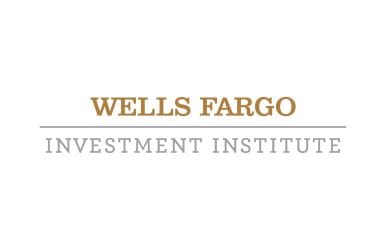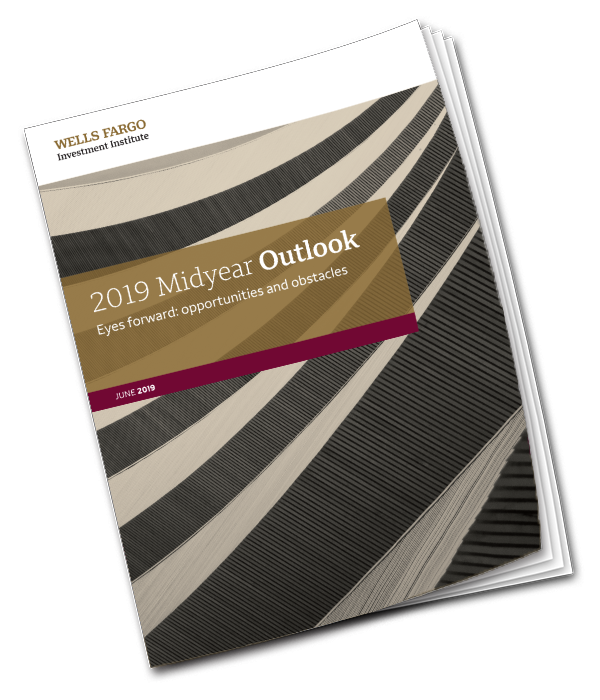Video Transcript
 June 2019 Transcript
June 2019 Transcript
2019 Midyear Outlook Eyes Forward: Opportunities and Obstacles
Presenter: Paul Christopher, CFA, Head of Global Market Strategy, Wells Fargo Investment Institute

[piano plays in background]
Drivers, pilots, and sailors always guard against the risk of drifting off course, of losing their forward focus. We believe it is important for investors, too.
The first part of 2019 produced sharp moves in financial markets, first lower and then higher. That kind of volatility can leave portfolios off course, that is, misaligned with their long-term goals.
For investors, we think the theme of keeping eyes forward is especially important right now, with markets at a crossroads.
“Eyes forward” means patiently seeking out select opportunities…it also means watching out for obstacles in the road.
We believe an economic recession is unlikely and growth, while slowing, should remain positive.
But in our opinion, challenges and uncertainties do lie ahead. Global trade is still contracting, there may be more potential geopolitical stumbling blocks in the second-half of the year, and consumer and business spending has slowed.
In our view, now is not the time to turn either too aggressive or too conservative with portfolio positioning.
[On-screen text: Portfolio guidance: Avoid being too aggressive or too conservative. Realign with long-term goals.]
We encourage investors to use midyear as a time to realign portfolios with long-term goals.
To find out what our top asset-class and sector choices are, as well as our top five portfolio ideas for the second half of the year, please download our 2019 Wells Fargo Investment Institute Midyear Outlook report titled: Eyes forward: Opportunities and Obstacles.
[On-screen text: For more information download our special report.]
Risk Considerations
All investing involves risk including the possible loss of principal. Investors should be aware of, and understand, all risks associated with a particular investment product before investing.
General Disclosures
The opinions expressed reflect the judgment of the speaker as of the recording date and are subject to change without notice. The material has been prepared or is distributed solely for information purposes and is not a solicitation or an offer to buy any security or instrument or to participate in any trading strategy. Past performance is no guarantee of future results. Additional information is available upon request.
The information contained herein constitutes general information and is not directed to, designed for, or individually tailored to, any particular investor or potential investor. This report is not intended to be a client‐specific suitability analysis or recommendation, an offer to participate in any investment, or a recommendation to buy, hold or sell securities. Do not use this report as the sole basis for investment decisions. Do not select an asset class or investment product based on performance alone. Consider all relevant information, including your existing portfolio, investment objectives, risk tolerance, liquidity needs and investment time horizon.
Wells Fargo Investment Institute, Inc. is a registered investment adviser and wholly owned subsidiary of Wells Fargo Bank, N.A., a bank affiliate of Wells Fargo & Company.
Wells Fargo Advisors is registered with the U.S. Securities and Exchange Commission and the Financial Industry Regulatory Authority, but is not licensed or registered with any financial services regulatory authority outside of the U.S. Non-U.S. residents who maintain U.S.-based financial services account(s) with Wells Fargo Advisors may not be afforded certain protections conferred by legislation and regulations in their country of residence in respect of any investments, investment transactions or communications made with Wells Fargo Advisors.
Wells Fargo Advisors is a trade name used by Wells Fargo Clearing Services, LLC and Wells Fargo Advisors Financial Network, LLC, Members SIPC, separate registered broker-dealers and non-bank affiliates of Wells Fargo & Company.
© 2019 Wells Fargo Investment Institute. All rights reserved. CAR-0619-00542
 View the full report (PDF)
View the full report (PDF)

 June 2019 Transcript
June 2019 Transcript





